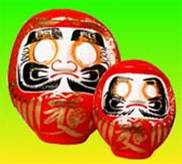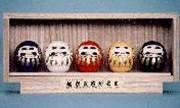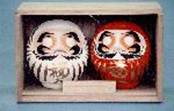|
11
|
| Do you buy a Dharma doll on New Year's Day each
year? Dharma dolls can be bought at Dharma doll fairs from
December to January at temples all over |
| Why do so many people buy these dolls
each year? The reason is that people want their wishes to come
true. They display the Dharma doll in their home and pray to have their
wishes granted.
Many Dharma dolls are made around Japan. There are various designs and shapes, but most are
round and red.
In Saitama, the city of |

|
|
There are now nine Dharma doll-makers in Makuri. They
make about 500,000 Dharma dolls each year. Koshigaya Daruma has several
unique characteristics when compared to other Dharma dolls. They can be
found at many temples all over
All Dharma dolls are made by hand. The height ranges from 4.5 centimeters to 100 centimeters. One characteristic that they all have in common is their mustache. The mustache is a very important point when making a Dharma doll, since its style can completely change the look of the doll's face. So, Dharma doll-makers put a lot of efforts into drawing the mustache. They use a special type of brush called a ‘Mensofude’, which has a long tip. The same brush is used for drawing mustaches on both small and large Dharma dolls. As a result, no two dolls look quite the same.
In 1984, the Koshigaya Daruma was designated as a
traditional handiwork of
|
|
Dharma dolls fairs だるま市 display 飾る pray 祈る grant (願いが)かなう Therefore したがって noble 上品な characteristics 特徴 compared to〜 〜と比べて range 〜に及ぶ diameter 直径 mustache ひげ tip 筆先 As a result 結果として was designated 指定された a traditional handiwork 伝統手工芸品 |
![]()
|
だるまはどのように生まれ、人々の生活に浸透していったのでしょうか。 |
|
Origin of the Dharma Doll |
| The Dharma doll is originally a combination of the
historical story of Bodai Daruma and Japanese paper-mache ‘Hariko’
toys.
Bodai Daruma was born in |
|
|
He sat and meditated for nine years
without moving. From this story, the Japanese people of the
Edo
period
imagined that a man who sat for such a long time would have lost his
arms and legs and grown a long beard. From this image, they thought that
he would have become round, like a Dharma doll.
The paper-mache ‘Hariko’
toy was originally created in Chinese Hariko were originally painted in the shape of old man. They were heavy at the bottom and would rise when knocked down.
|
|
菩提達磨像 |
| Chinese Hariko were introduced to
Toy-makers in It was originally thought that Dharma dolls were good for curing illness because they quickly rose after being knocked down. The color red was thought to protect against small-pox, so Dharma dolls were colored red. These days, we can see various colored Dharma dolls. People use Dharma dolls to pray to the gods for happiness at home and prosperity at work. |

|

|
|
paper-mache 張り子 founder 創始者 Zen Buddhism 禅宗 meditated 瞑想した bear ひげ toy おもちゃ create 創る paste 貼る bottom 底 rise(roseは過去形) 起き上がる The Ming Dynasty 明の時代 humor ユーモア added つけ加えた round 丸い were reminded of ~ 〜を思い出させた curing illness 病気を治すこと small-pox 疱瘡(ほうそう) various 様ざまな prosperity at work 商売繁盛 |